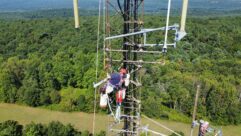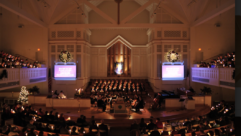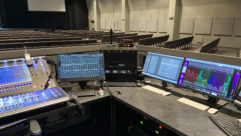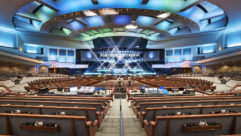
Satellite Churches
Oct 7, 2010 2:29 PM,
By Bennett Liles
Multisite ministries become a technical reality.

Senior Pastor Jack Graham at Prestonwood Baptist Church in Plano, Texas. The church has a video-linked second location at Prosper, Texas, 17 miles north of Plano. The church reaches thousands by TV, radio, and Internet.
Few would doubt the positive impact that television has had on the church since Oral Roberts first took to the TV airwaves in 1954 and as thousands of churches have televised their services and begun streaming them to the Internet. But today’s concept of growing a church has come to include the group energy, fellowship, and total worship experience that watching from home cannot provide. For an increasing number of churches trying to grow but faced with limitations on expanding their home sanctuary, going multisite offers a powerful solution. Jim Tomberlin, founder and senior strategist at Scottsdale, Ariz.-based MultiSite Solutions, says that the multisite church offers a whole new experience.
“There is a big difference between a broadcasted TV service and a multisite campus. A typical multisite campus is a fully functioning worshipping congregation with a local pastor who shepherds the flock and where ministry occurs throughout the week,” he says.
According to Tomberlin, the multisite trend started in the mid-1990s as a band-aid solution among a few innovative megachurches that found themselves out of room or facing zoning restrictions on campus expansion. It quickly spread as a strategy that any healthy, outreach-oriented church could use. Central to the multisite method is a franchising concept that is easier to draw people to the church if you can physically spread the church around the community through unified satellite locations. For many of these churches, the way to join their local congregations has been through a video link. In many cases, that link began as an analog RF-modulated TV signal sent on coax to an adjacent room or building used as an overflow space. The logical next step was to apply the idea over a greater area.

Jim Tomberlin
The Leadership Network—an organization that provides churches with growth strategies, innovation methods, and other resources—recently conducted a survey indicating that among the 3,000 multisite churches in the United States, 34 percent use a combination of video and in-person methods while 20 percent use video primarily. The survey also showed that multisite churches have been very successful and that the movement is spreading worldwide.
The three basic components of the video link are capture, delivery, and presentation. There are options within each phase that can be customized to suit the message, congregation, budget, and expertise level of the tech people available. Tomberlin sees the recent technical trends.
“High definition is becoming the standard for video presentation,” he says. “Though satellite transmission is increasing, video streaming over high-speed, broadband Internet will become the primary vehicle for delivering sermon content. Still, the most common, least expensive, and [most] reliable way of sermon delivery is videotaping and delivery utilizing DVD or hard drive.”
Capture
Indeed, some of the churches with the most professional video production operations have chosen not to go live to their other sites but to record the sermon and distribute it either by FTP, streaming for delayed local playback, or by physical delivery on a DVD or hard drive. The latter method can take advantage of an innovative software solution to enhance the viewing experience. In the originating sanctuary, the stage is often flanked by large IMAG screens. The sermon is recorded on two simultaneous video streams. One carries the wide stage shot while the other has the close-up IMAG video. They are both recorded onto the same hard drive using a software application called ProVideoSync from RenewedVision. The hard drive or its video is sent to the satellite venue and using a ProVideoSync playback system, the wide-shot primary stream is displayed on a large, high-def screen onstage while the synchronized IMAG video stream plays to the side screens just as it appeared at the originating church. The main screen and the shot on it are arranged so that the pastor appears life-size onstage. Subtle frame-by-frame synchronization adjustments between the streams can be manually done while they are playing for the audience.
Satellite Churches
Oct 7, 2010 2:29 PM,
By Bennett Liles
Multisite ministries become a technical reality.

Senior Pastor Cal Jernigan appears onscreen at the
Central Christian Church of the East Valley with more than 8,000 in attendance among its three locations in Mesa, Gilbert, and Queen Creek, Ariz.
Good sound for video linking revolves around how much reverberation is transmitted to the viewing venues. A lapel microphone on the pastor can form a tough combination with a high-level sound system that relies heavily on acoustic throw for coverage. A better sound system for the originating sanctuary uses a higher number of very directional speakers or arrays, each of which covers a smaller area, enabling all of them to be operated at a lower volume level—distributing the sound more by wire than by acoustic power. This reduces the amount of sound bouncing back with delay into the pastor’s microphone. Although it’s largely a matter of personal taste for the presenters, audio people love pastors who use head-worn mics because these vastly increase gain before feedback and reduce reverberation heard at the other end of the transmission. In-ear monitoring also keeps the video-linked stage acoustically clean, considering that any reverberation picked up on the pastor’s mic will be again blasted out over a main house sound system into another reverberant environment in the receiving sanctuary. This can result in a crisp, intelligible sermon sounding like it’s coming from the bottom of a well to the satellite congregations.
The same concept applies to having adequate light levels on the main stage along with projector brightness and control of ambient light on the screens at the satellite churches. The grainy, old movie look is fine for old movies, but it’s deadly for big screen sermon viewing. Many video-linked churches use a high-def video signal for the main wide-shot screen and a standard-def signal for the smaller IMAG monitors while others choose to go with 1080p on all screens.

The Southland Christian Church in Lexington, Ky., converted a Lowe’s building into a satellite campus, seating 500 in nearby Danville. The congregation watches a service from the Lexington campus tape-delayed from the previous night.
Delivery
Regardless of the specific production method, the fastest developing delivery technology is private network or Internet streaming using equipment such as the Streambox SBT3-5100 and SBT3-7100 systems along with a Streambox Broadcast Server, the StreamZ Live streaming media encoders from Digital Rapids, the Niagara series streaming products from ViewCast, the VBoss encoding package from VBrick, or Hai1000 series video system from HaiVision. There are some important considerations on the transmission element, especially if the intent is to send out live video. Melissa Johnson at Streambox says that bandwidth needs are set to some extent by worship style.
“I would suggest 6Mbps to 10Mbps, depending on the content of the video,” she says. “A traditional service with less motion [in the video] could use less bandwidth. For more contemporary churches where the services contain a lot of movement, lights, and music, I would suggest more bandwidth. More complexity and motion uses more bandwidth.”
Streaming transmission is the area in which the tech crew for the church has the least control if the solution involves public Internet conveyance rather than a segmented IP subnet on the church network or an expensive dedicated T1 Internet connection. Even if the church computer network connects the venues, it’s never a good idea to try mixing the video transmission with office applications traffic on the network. Options for Internet streaming have never been better as compression techniques have matured and encoding/decoding gear has become easy enough for church volunteers to operate with little training or experience. Any church getting its sermon live on the link should have a backup link or a backup content plan. In transmission only for delayed local playback, some churches just do a large file transfer, but in this case, the sermon must be playback tested while there is still time to resend the file. Many have chosen to stream the sermon in realtime, recording it locally, and then testing playback for sound, video projection, and content.
Presentation
For the service, two players running simultaneously is inexpensive insurance, but in either case, the local pastor must always be ready to take over. In presentation technique, there are methods that can enhance and unify the experience at the viewing end of the stream. Continuity of lighting and staging are subtle concepts, but they can contribute a great deal to the visual feel of being in the same room with the pastor on the screen. The color and intensity of the lighting at the receiving venue should match the atmosphere created on the stage at the transmission end, and the platforms and set design should be created by the same team or patterned closely after those on the video stage. This is all done to eliminate any sharp contrast in appearance at the edges of the central screen.
Lighting is the most versatile element, and nothing draws the congregation’s attention to the screen more dramatically than a lighting change. Lighting can be used to control the entire visual theme, unifying it with the home church during the sermon and then smoothly shifting to a different local motif afterward. For churches at the receiving end, the projector is no place to save money, and if the budget is tight for a high-lumen long-throw machine, rear-screen projection is one option, but ambient light, sanctuary size, viewing angles, and screen mechanics are prime topics for consideration. The options are vast, so once the decision has been made to link multisite churches by video, let the message crafting begin.










